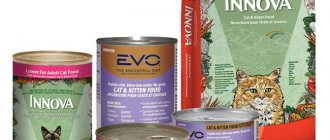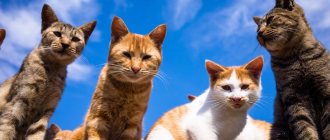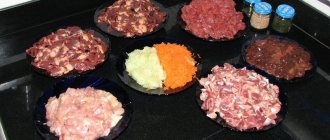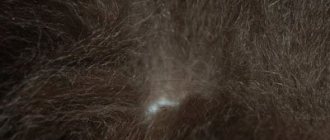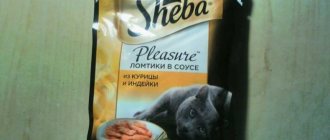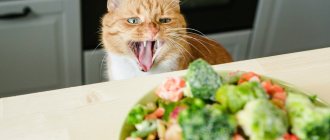Historically, the cat originated from the southern arid regions. This is an obligate predator, adapted to feeding on whole carcasses of small animals. Knowing this allows us to highlight the main features of cat nutrition, which, in turn, are necessary to understand how to properly feed cats.
Cat needs
In order to choose the right diet, you need to understand what your pets need. It would seem that everything is the same as everyone else’s: the need for protein, carbohydrates and fats has not been canceled, but it is important to take into account the ratio of these elements in the diet. A cat is a carnivorous animal, and animal protein is of great importance to it. Taurine is also important for cats, an amino acid that they naturally obtain from the tissues of captured prey.
Recommended percentage of nutrients in cat food:
- protein – 36%;
- carbohydrates – 34% (of which 4-6% should be represented by cereals and vegetables);
- fats – 30%.
Missing vitamins are compensated for by special supplements sold in pet stores and pharmacies.
conclusions
So, the health and longevity of a cat depends on a properly selected balanced diet. The basis for determining how to properly feed an adult cat is an understanding of its individual characteristics and the characteristics of its physiology as a biological species. Any cat, first of all, needs products of animal origin, supplemented with a vitamin and mineral premix. In general, any owner of a tailed friend is able to independently choose the right diet for their pet, however, in some cases, animals require a special diet, which can only be prescribed by a specialist.
Types of diet
Traditionally, a cat's diet can consist of dry, wet and homemade food. Each type has its own characteristics, so I propose to consider them in more detail.
Dry
Dry food is a popular feeding option for most indoor cats. It is not difficult to find it, as it is sold even in the nearest supermarket. Manufacturers offer balanced nutrition for your four-legged friends in the form of croquettes or cookies. According to experts, dry food is dried and compressed wet food.
The amount of moisture in it is up to 12%, which causes extreme thirst in animals. That is why it can be stored for a very long time, does not spoil in the cat’s bowl, no matter how long it sits, and also has a strong aroma that attracts predators.
Wet
Wet food looks more attractive and has a pleasant aroma. They are complete and additional to some diet (for example, when owners practice feeding wet and dry food at the same time).
Home
This type of diet means preparing food for your pet yourself. It seems that there is no better option, but it is worth considering that without sufficient skills, and sometimes even time, we cannot balance the diet in such a way that it meets the needs of the pet.
It would be a mistake to think that feeding a cat from your table will be a good alternative. Animals should not be given fried, fatty, spicy foods, and some foods are even contraindicated.
I found an interesting video from a candidate of veterinary sciences about feeding cats natural food:
Rule three - water must be present
Moreover, the water is clean and always fresh. Some owners, again showing dubious concern for their pet, replace it with milk. However, this should not be done with an adult cat, otherwise he will have problems with the gastrointestinal tract.
The volume of fluid is also important - if you feed your cat dry food, you need to triple the daily amount recommended by veterinarians. In this case, it is calculated depending on the amount of feed: it should be three times more.
There are cats that drink little, for whom choosing unmoistened food can even be dangerous. If you cannot give canned food for some reason, you need to pre-soak dry cat food in the appropriate proportion. It turns out to be a kind of soup: at first the animal may refuse it, but if you are persistent, it will gradually get used to it and feeding it will become easier.
Feed classes
It is generally accepted that food is divided into several classes: economy, premium, super-premium and holistic. I suggest you find out more about each.
Economy
Most popular foods belong to this class, for example, Whiskas, Friskies and other dry foods from the nearest supermarket. Many breeders do not welcome the purchase of dry food, especially economy class.
The fact is that the cheapness of a product may indicate its low quality. For example, the composition may include meat that has expired or products that are not suitable for consumption.
Things to think about
Wanting to reduce the cost of food, manufacturers can add grain crops and write on the label that the protein content is normal. But this protein is not suitable for feeding a predator and can cause harm.
Never purchase food if its composition is not indicated on the packaging or if you doubt the quality of the product!
Not all food is bad, but you should make sure that the manufacturer is reliable.
Premium
An acceptable food option for animals without harmful additives and meeting the need for nutrients. The most famous representatives of this class are the Royal Canin and Purina Pro Plan brands.
The food of these brands is well absorbed by the body and does contain meat (the manufacturer indicates the percentage), but the presence of preservatives is not denied. An important fact: such foods are relatively inexpensive and can be easily purchased at your nearest pet store.
Super premium and holistic
These varieties are less advertised, and therefore they are known mainly by breeders who buy expensive food, literally investing in their business.
Feeds of these classes are distinguished by high quality meat, the absence of preservatives and dyes. They are developed together with nutritionists, which means that if fed properly, the animal is not at risk of obesity.
Rule two - only the best
To properly feed your cat dry food, you need to choose only the super premium category.
© shutterstock
Cheap ready-made food has a number of significant disadvantages:
- made from completely useless parts of animals and birds - hooves, feathers, bones are processed for it;
- This food contains a lot of gluten, and this is completely unacceptable, since it is one of the most powerful cat allergens.
So economy-class food poses a direct threat to the cat’s health.
Refusal to eat
Refusal to eat may indicate an animal illness. Remember: a cat should not starve for more than a day! After this, irreversible changes begin in the liver, when its healthy cells are replaced by fat cells. Take your pet to the vet immediately. For animals weakened by disease, there are special liquid feeds.
Also, a cat may refuse to eat if it cannot smell it or if the smell is unpleasant. Therefore, wash your cat’s dishes regularly and monitor the quality and expiration date of the food.
Each pet should have its own bowl for feeding. The cat may not eat from a common bowl, and if you have several aggressive pets, this will lead to conflicts. Read about how to make friends with cats in a separate article.
Appropriate place
Finally, we note that it is completely unacceptable to place a bowl of food near the tray or in the bathroom. Some owners do this with what they think are the best intentions: after all, scattered food is much easier to remove from the tiles. We can only answer one thing: if perfect order in the house is so important to you, be prepared to clean up after your pet.
Feeding a cat next to the litter box is guaranteed to “break” its feeding behavior: these animals do not naturally make a toilet in the place where they eat.
___________
© All rights reserved. Partial or complete use of materials is permitted only if there is a link and/or a direct hyperlink open to search engines to the direct address of the material on the website Holistic-shop.ru.
What not to feed a cat
If you practice a homemade or mixed diet, it will be useful for you to know what you should not feed your cat.
- Sweets. If you want to pamper your pet, purchase special treats at the pet store.
- Raw meat, fatty meats. Along with this food, parasites can enter the cat’s body and cause illness.
- Tubular bones are taboo. They injure internal organs and lead to death. Even boiled tubular bones are very dangerous.
- Tomatoes, eggplants, grapes, the ripeness of which you cannot check, as well as the green parts of these products, as they contain substances that are poisonous to cats.
- Dairy products. They can be found in the diet of kittens up to 8 months, but not in the diet of adult cats.
- Onions and garlic damage red blood cells and can lead to anemia.
- Expired food, different types of food mixed in one bowl, as well as food intended for dogs or rodents.
Psychological comfort
If an adult cat eats little or a lot and you are already tired of changing food, it may be worth thinking about the environment in which the pet eats. We have already said that one of the main problems may be a nervous environment when eating in the “cat canteen”.
How do you understand that there are problems and what can be done about it?
| The main thing that any pet should feel around its bowl is safety. If something frightens a cat, it will either try to eat in a hurry (which is not very healthy), or will begin to refuse food altogether. |
Here are signs that something is bothering your cat:
- wary, fearful behavior, the animal flinches at every rustle;
- constant attempts to look around;
- ears erect or “in airplane position” (set apart horizontally);
- the cat is hunched over or curled up into a ball.
So what makes a cat nervous? Perhaps it's other family members. Let's say the bowl is in the hallway and passing family members disturb the dining pet. Or an overly playful or loving preschool child terrorizes a pet without realizing it.
Then try moving the bowl under the table or to another hard-to-reach place. Sometimes the problem can be solved by turning the eating area so that the cat sits with its back to a wall or other safe area for it. Some “vertical” cats who like to climb and jump are happy to have their food bowl moved onto a nightstand or low shelf.
Nutritional features of allergic cats
Food allergies affect every tenth cat. Carrying out allergy tests for them often gives false results, so the cause of the reaction is identified by the method of exclusion. If there is a suspicion of food hypersensitivity, try to eliminate possible sources:
- products with chemical components;
- flavor enhancers;
- preservatives;
- flavorings;
- food additives.
Cats should not be allowed to eat natural and commercial food at the same time. If, as a result of restrictions, no improvement has occurred, the cat is transferred to hypoallergenic food containing only hydrolyzed meat and a minimal amount of carbohydrates (one grain).
The most common natural allergens are:
- milk;
- seafood;
- chicken;
- soy;
- corn grits;
- chicken egg white.
How many times a day
The frequency of food intake depends on the age of the pet:
- a kitten from 1 month to 3 months is fed 6 times a day, at regular intervals;
- from 3 months to six months he is gradually transferred to three meals a day;
- It is acceptable to start feeding a cat older than 8 months twice a day, like an adult.
The age limits given are general. You need to watch the baby. If a nine-month-old kitten, with two meals a day, runs after its owner and begs, then the third meal needs to be returned. It should be taken into account that large breeds (for example, Maine Coons, Ragdolls) continue to grow up to two years, they need to be transferred to an adult feeding regimen taking into account their individual characteristics.
Fold
There is still a widespread misconception that calcium in the food of fold-eared cats needs to be limited so that their ears do not stand up. This is wrong.
The position of the ears of Scottish Folds is primarily influenced by genetics; environmental conditions (heat, stress) and age also play a certain role. Ears may perk up in pregnant and lactating cats.
As for genetically determined osteochondrodysplasia, nutrition has little effect on the development of this disease; in any case, it is incurable and inevitably progresses. The only effective way of prevention is not to breed folds with folds and not to take lop-eared kittens from such matings from breeders. For kittens whose only one parent is lop-eared, this problem is not typical.
Nutritional features of overweight cats
Obesity in cats is a common pathology in pets. It has an extremely negative impact on the condition of internal organs and threatens the development of serious diseases.
If pets are fed a ready-made industrial diet, choose lines for animals prone to gaining excess weight, but first you should consult with a veterinarian to check if the cat has hormonal disorders or other diseases.
Overweight pets who are fed “naturally” are fed according to the following rules:
- reduce the volume of portions;
- increase the share of grains in the diet;
- Fermented milk products with a low fat content are introduced into the menu.
If you balance your diet and don’t feed cats and kittens from the master’s table, but they still gain weight, this is a serious symptom of health problems that need to be addressed immediately by contacting a veterinary clinic.
Menu for cats
It’s easy to prepare delicious and original dishes that cats and cats eat with pleasure at home:
- Balls - boiled rolled oats, egg yolk, carrots are added to minced beef, formed into balls and frozen.
- Cabbage with meat - mix puree of raw cauliflower and chopped meat scalded with boiling water.
- Pate – boil chicken by-products and carrots, grind them into a paste, add broth and butter, mix thoroughly.
- “Moor-meow” liver - 100 g of chicken liver, a piece of cheese and banana, carrot puree, rolled oats, mixed and simmered over low heat.
- Boiled chicken fillet with porridge - chicken meat is boiled, chopped, oatmeal is added, and broth is poured over it.
- Pancakes - grate frozen beef, add carrots and chicken egg yolk, form into flat cakes and bake in the microwave.
Mixed feeding – harm or benefit?
Some breeders decide to use mixed feeding. This diet involves the simultaneous consumption of ready-made food and natural food.
Such feeding will do more harm than good:
- The intestines digest natural food after 1.5-2 hours have passed. At this time, the finished product is in the pet’s stomach. This process has a negative impact on the digestive system.
- Any mixed diet will eventually lead to diseases of the digestive system.
Breeders note that when mixing feed, the animal may completely abandon natural ingredients.

